I heard the word tablea— also spelled tableya— so many times over my first couple of weeks in the Philippines, back in 2017. I even bought some honey tablea in Bohol a couple of years ago. Then again, when I went back in to research Philippine cacao culture, I really got interested: what IS tablea? And where's all the Filipino chocolate?!

Jump to:
🎓 What Is Tablea, Or "Tableya?"
Put simply, tablea is a ball of ground-up cacao beans, usually heated and combined with water to make a traditional Filipino chocolate drink called sikwate. Many people cite that the name tablea (or tableya) refers to the Spanish word for "tablet," a reference to the food's shape.
But the name may also come from the Spanish word tablear, meaning rolling and dividing, an allusion to the way in which the balls are formed. In researching this article, I've learned that when a Filipino's chocolate craving hits, it's usually not for a bar of chocolate, but for a steaming cup of breakfast tablea.
A local cacao farmer in Davao told me that Filipinos usually spell with their ears, which would explain the variations in spelling. Whichever word you choose is a matter of preference, just like how you choose to prepare your tablea.

❓ How Is Tablea Made
Cacao beans are the agricultural product used to make chocolate.
To make chocolate, the beans are harvested, fermented, and dried, and then they're roasted, peeled, and ground into a smooth cacao mass. The purest chocolate is cacao mass, plus sugar.
But to make traditional tablea, you simply grind the cacao beans a little less, and then form the mass into balls to store for later use (instead of adding sugar and refining further). For those who grew up with expiration dates on everything including hot chocolate, you may be wondering, does tablea expire?
The answer is no. The higher percentage of fat means that it your tablea could have some cocoa butter rising to the surface and making it appear grey and moldy, but rest assured that it's still fine to consume.
In fact, most tablea will start to look like this at some point, since it's not traditionally tempered (meaning that the food's fat structure is stabilized). So old tablea should be just fine to eat, as long as it still tastes good.
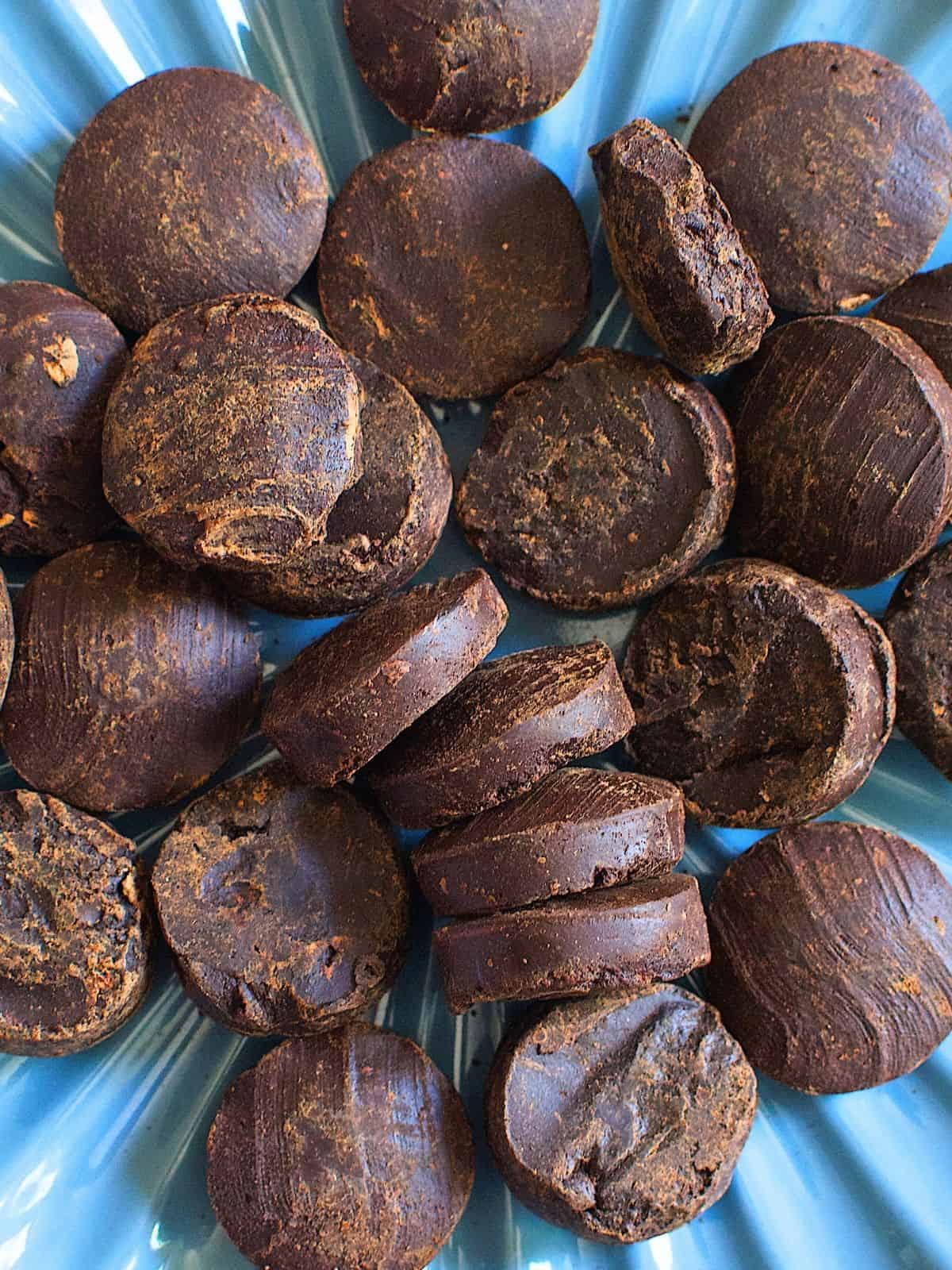
Tablea is different from a hot chocolate mix because it contains more natural fat. To make the cocoa powder used as the base in most hot chocolates, companies take the aforementioned cacao mass and press out most of the fat, to use in cosmetics and other industries.
Then they alkalize or "dutch" it to make it dissolve better in water and have a more uniform flavor. So tablea is basically full-fat hot chocolate base, with your own choice of how much sugar and/or milk to add.
Unfortunately, many Filipino farmers have historically not fermented their cacao, and most still don't. This means that the flavor of their tablea is often bland, or even worse, acidic and earthy without much chocolaty flavor at all.
The process of fermentation is crucial in both chocolate making and tablea production, because it's one of the two most important steps for flavor production within the cacao bean itself. So make sure your tablea says it was produced with fermented cacao, especially if you plan to mix it with milk and sugar.
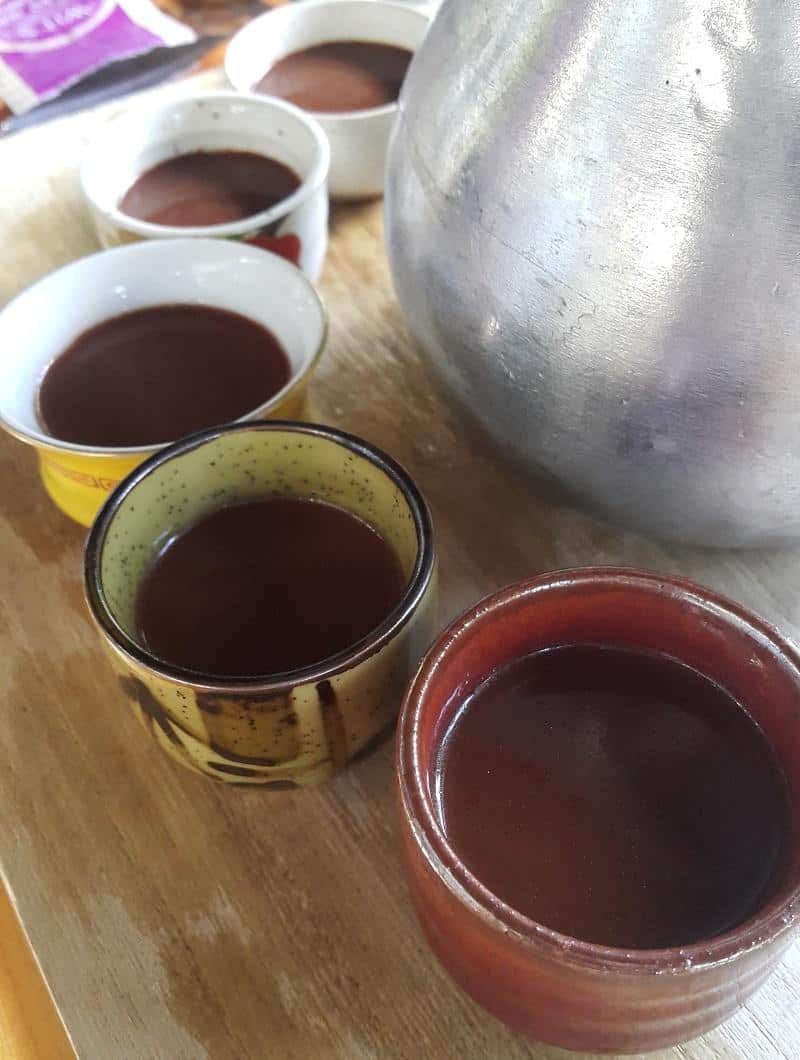
📚 History Of Tablea
Theobroma cacao is the tree from whose fruit chocolate is made. At the time of Spanish Colonization, the tree was being grown in both Central America and northern South America, and its seeds were prized by many native peoples.
In turn, the Spanish found value in it, as well, bringing seeds to try and cultivate in each of their colonies, including the Philippines. At the time, cacao was only consumed in the form of a beverage, as the Aztec & other native peoples of Mexico were consuming it.
So when the Spanish colonizers successfully cultivated cacao on the Philippines, that's the only way it was being consumed: as a drink. But this wasn't a drink for just anybody; the Spanish cacao farms were watched over by priests, and those same priests had a huge say in who could consume it.
When you visited one of these cacao plantations, if you were deemed worthy enough then you were served a cup of tsokolate, the Filipino word for "chocolate." But within the world of tsokolates, there were two types: Tsokolate Eh and Tsokolate Ah.
Filipino Tsokolate Eh was "espresso" chocolate, meaning the most concentrated form of the beverage, reserved only for the most worthy of visitors. While Filipino Tsokolate Ah was chocolate "aguado," or "watered down."
It was a lighter version of the beverage, and serving it meant that you respected the person's position, but not that much. For centuries this traditional Filipino hot chocolate has been and is still the most popular way to consume cacao throughout the Philippines, especially as it's gone from a colonizer's beverage to the drink of the people.
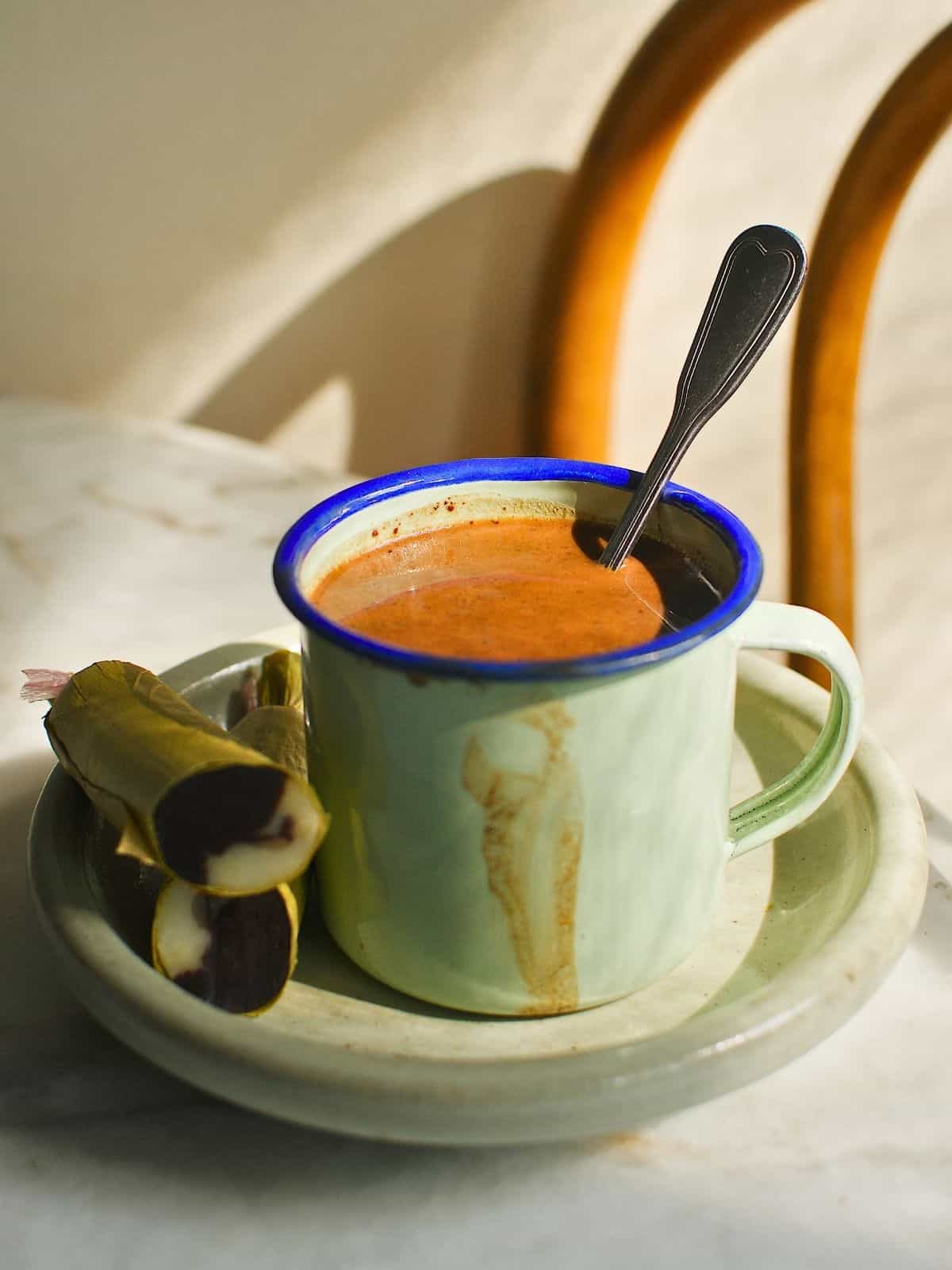
📝 Domestic Consumption of Tablea
Similar to the chocolate caliente in Baracoa, Cuba, and many other part of Latin America, Filipino hot chocolate is usually served with breakfast. If you don't add much sugar or milk, it's a rather bitter and mild-flavored beverage, much like coffee.
These days, mothers and grandmothers are generally in charge of making & serving the morning sikwate. Even though its consumed across the country, and even caused a cacao deficit in the Philippines in recent years, it's not really something you'd order in a cafe.
Tableya is and has always been a food made and consumed in the home, with all of the preparations that entails. This includes other forms in which tableya is consumed, like in the traditional Filipino dish of champorado.
For those who still make tablea at home, if they don't have a cacao tree in their yard, they buy cacao beans from a local market. Then they bring those beans home and roast them over a fire, peel off each individual shell, and grind at all up in a blender.
It's a rather arduous process, so most people opt to buy tablea from the supermarket these days, though more & more artisanal tablea makers are popping up now (even as far away as Belgium).
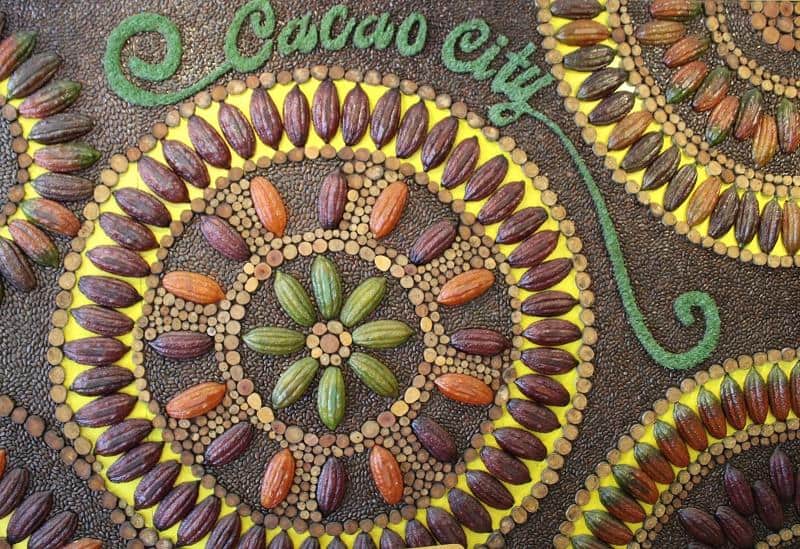
Consumption of the aforementioned tsokolate drinks has also changed over time, as eating chocolate and chocolate beverages have become distinct foods with shared roots. In modern times, tsokolate is the Filipino word for "chocolate," while sikwate is the Filipino word for the beverage made with tableya (often called "Filipino hot chocolate drink").
You can also find international hot chocolate mixes, like Swiss Miss, in some Filipino supermarkets. So many Filipinos don't even associate tablea and sikwate with the world of pre-packaged hot cocoa mixes and sugary chocolate bars I grew up on in the US.
But this doesn't mean that tablea has dodged the issue of adulterated quality. Most of the tablea brands I found in the supermarkets in Davao City contained something other than cacao, be it corn starch or wheat germ or something else.
This means that even though Philippine tablea is just as popular as ever, those who opt to buy from the supermarket may not be getting the same quality as they might have been a few decades ago.
Additionally, over the years, it's become increasingly popular to prepare your sikwate with milk instead of water, and even to sweeten it further with condensed milk. This is most popular amongst younger generations, but it's only becoming more widespread.
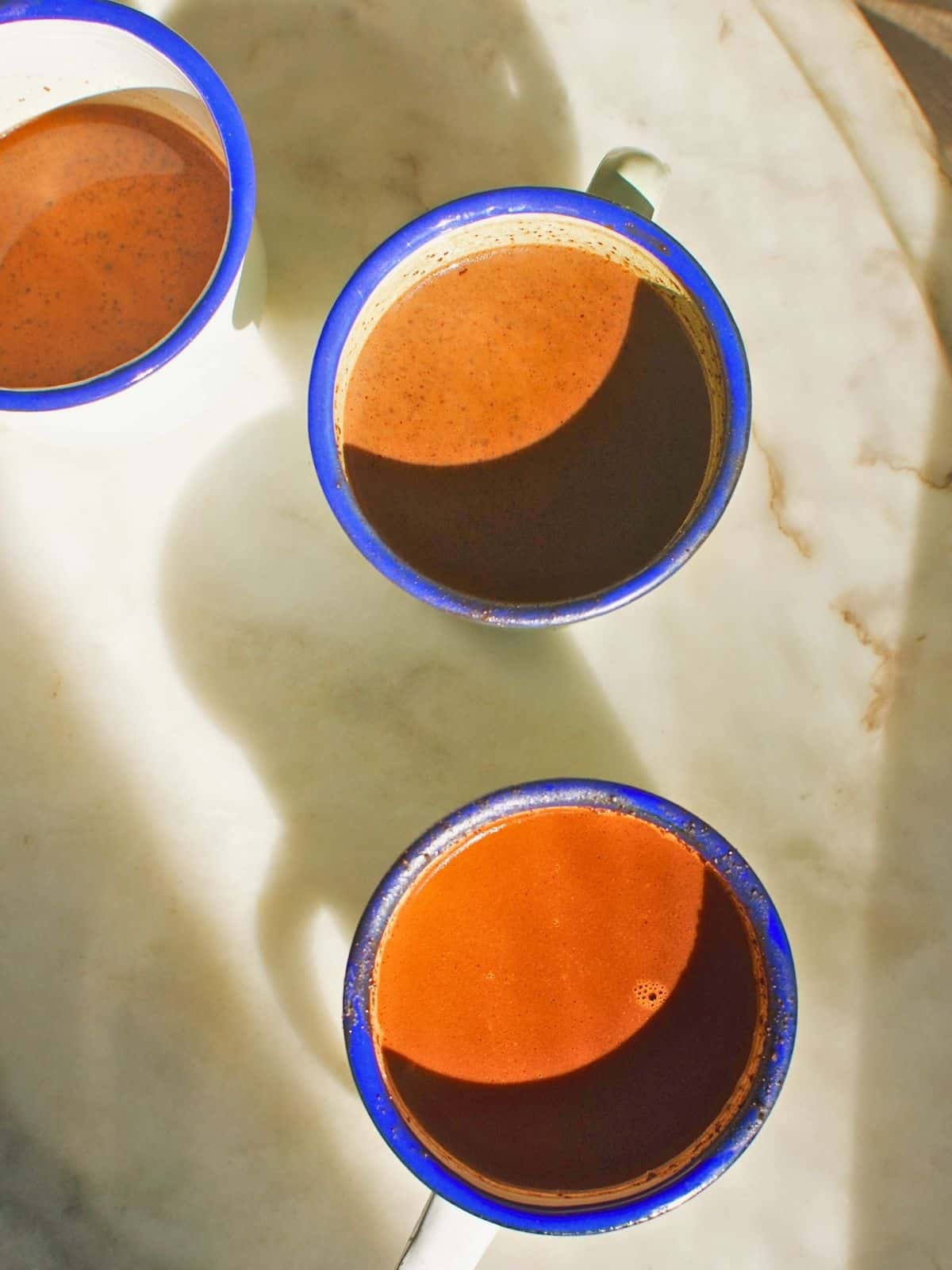
✔️ Where To Buy Tsokolate Tablea
If you're in the Philippines, buying tablea is as simple as going to your local supermarket and asking where the tablea section is. But be sure to read the packaging before buying, as "pure" and "natural" are just marketing words; the important information is on the back, in the ingredients list.
Yet just as easy, if not easier, is to order tableya online, preferably from someone making tableya from well-fermented and -dried cacao that they grow themselves. Davao City, in the island region of Mindanao, is famous for growing much of the country's cacao.
There are over a dozen tablea brands based in Davao alone, and you can see some of them here. Unfortunately, very few companies have the means or demand to export their tablea, in part due to the aforementioned & ongoing cacao deficit in the Philippines.
So if you're located outside of the Philippines, but want to buy tableya online to prepare at home, I'd recommend checking out Cacao Culture Farms, based in Davao. They now ship internationally, though don't forget about the year-round warm weather shipping fees.
Askinosie Chocolate, out of Springfield, MO, USA, also has a tableya brand that may be available internationally.

🙋🏻♂️ Frequently Asked Questions
Once the cacao has been harvested & processed, roast the beans until some beans have popped but before they begin to burn. Once cooled, peel off the beans' husks and put your cocoa beans into a very high-speed blender. If you have a mortar and pestle, that also works. Once the beans turn liquid, pour that liquid into a bowl to slightly cool or pour directly into molds. Voila! Tableya.
Tablea in English is technically just tablea. We'd also call the substance a roughly-ground chocolate liquor or even cacao paste. However, if you're asking what is the meaning of tableya, in English, then the word itself is believed to have come from the Spanish word for 'tablet,' as the balls of tableya resemble tablets.
Though both made from cacao, cocoa powder is like a super-low fat tableya, so you can't always substitute one for the other. To turn tablea to cocoa powder you'd need to liquefy the tablea in a very high speed blender, and then put the mass into a mesh bag for the cocoa butter to drip off.
After the de-fatted mass cooled, it would need to be carefully powdered and kept in a cool space. Best to just buy cocoa powder, unless you have a way to make up for the extra fat from the cocoa butter.
There are plenty of tablea recipes out there, but not many which tell you what to do with it once you've got it! My favorite uses for tableya, beyond the traditional sikwate, are in mole chicken sauce, champorado, and my grandma's chocolate frosting. If you're not sure how to use tablea up, try searching for recipes using baking chocolate.
Since the shelf life of tableya is literally years, it's important to store the cacao tablets in an air-tight container so as to not lose its fragrance & flavor. Tablea's shelf life can be extended by keeping it in a cool, dark spot where it won't develop bloom.













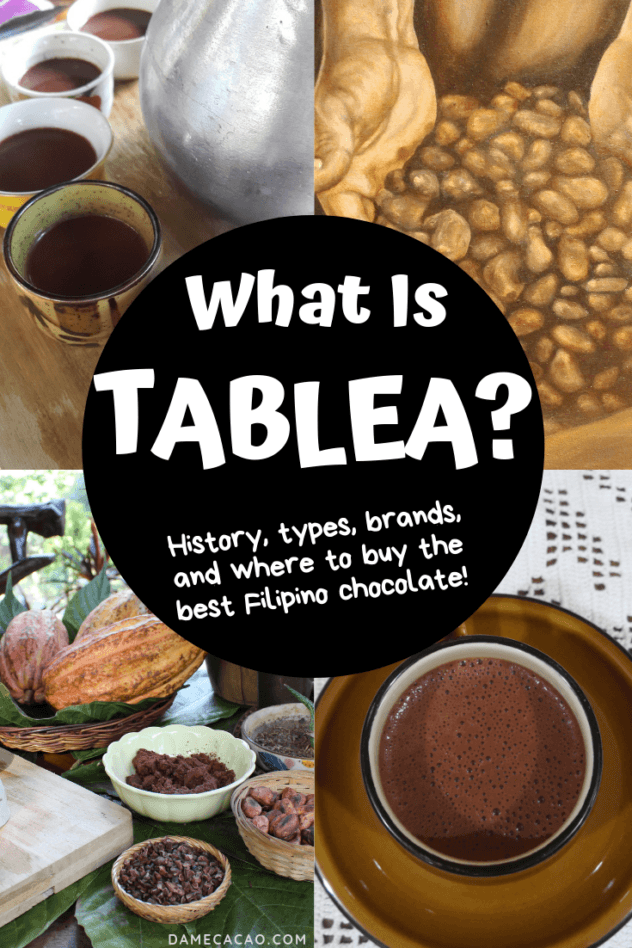
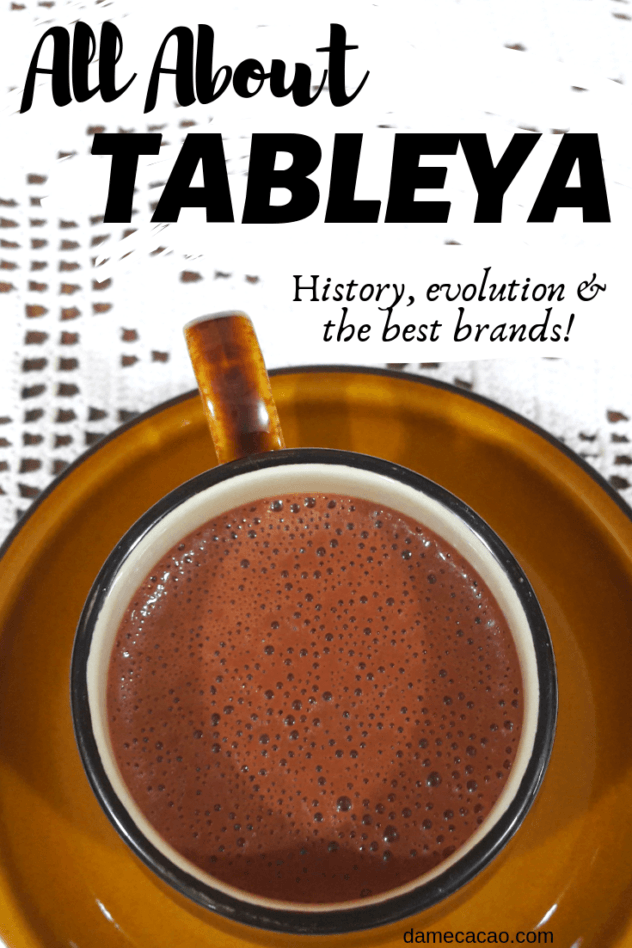
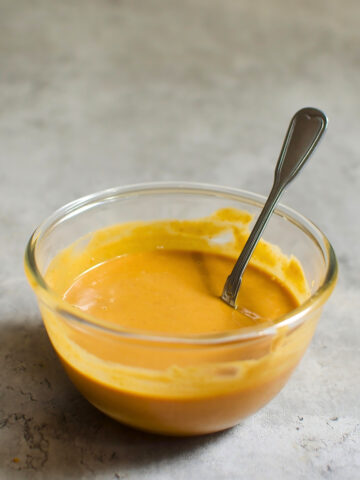
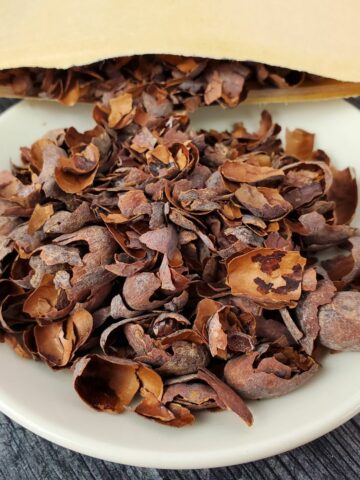


Helen Sheats
Thank you for your informative blog that answered all my questions! My husband likes it very much and we brought some home with us, but I was annoyed with the time-consuming process because they are slow to dissolve, so I tried my own idea of pouring a little boiling water over them in a cup, stirring to dissolve, and then using my frother to mix it well and filling the cup with more hot water or milk (be careful to not spill it out with the frother!). Works great!
Max
My pleasure, Helen! I'm glad you found a way that works for you - and tastes great, to boot! Thanks for taking the time to leave a comment. 🙂
Random Passerby
A bit of corrections:
"Tabliya"/"Tableya"/"Tablea" is from Spanish "Tablilla" (tablet).
"Sikwate" (also "Sikulati"/"Sikulate") is simply the phonetic corruption of Spanish "Chocolate" (pronounced Choh-Koh-Lah-Teh) in the Visayan languages (the Philippines has around ~170 different languages). Similarly "Tsokolate" is the Tagalog phonetic spelling of "Chocolate".
They mean the same thing. What would be called "Sikwate" in the Central and Southern Philippines, would be called "Tsokolate" in the North.
"Batirol"/"Baterol" is again, a phonetic corruption of "Batidor" (which is also used, it comes from Spanish for "whisk" or "beater"; "Batil" in Tagalog and Visayan also means "to mix", from Spanish "Batir"), which is what the Molinillo is called in the Philippines. It's the little wooden thing that you spin in the palms of your hands to make the chocolate frothy. In some regions, it's also called "Molinilyo".
The metal jug/pot itself is called a "Tsokolatera", the local spelling of what in Spain and Latin America would be called "Chocolatera".
Max
These are not actually corrections, but excess info about the likely origins of various words that I chose not to include in an already 2300-word article, but it's nice of you to write all this out for people, Random Passerby. 🙂
Edgar
I do not believe the Spanish brought cacao seeds and planted in the Philippines.
6 to 8 months voyage from Acapulco to the Philippines, impossible for cacao seeds to survive,
Should be, we have our own native or indigenous cacao, people do not know its uses. Spanish knew, they claimed our cacao to be their cacao.
Max
With respect, many plants can be kept alive and/or their seeds/seedlings kept moist enough to survive such a voyage— by that logic, all the cacaos in various parts of Africa, Oceania, and other parts of Asia are also native to those lands, only because those are also multiple-months' journeys from Spain.
chris
Unfermented tablea when done right is much more delicious as compared to the fermented tablea that tastes like your ordinary everyday chocolate drink from the grocery.
But what stands most for unfermented cacao, is how high its antioxidants are as compared to the fermented ones.
Max
It definitely depends on the varietal for both the taste & the antioxidant difference, but you're also right in that there is a difference!
Francine Maaño
Tablea can also be found in Camiguin Island! look for Maestrado's Tablea it is the best Tablea in the island of Camiguin.
Max
Great tip, Francine, thank you!
Rin
Reading this while drinking sikwate, in the middle of summer here in PH. This is very informative. This drink is part of my daily life and I didn't even know most of the info you provided.
On a side note, I like the unfermented tablea. I like the earthy and bitter taste, the stronger the better. I just mix it boil with the water.
But I can only have unfermented ones when I go to my province since I can request to my grandma to make it like that. Supermarket variants have the chocolatey taste, which is not bad too.
Max
Oh wow, well I'm glad to have shared some new tidbits about something you've been enjoying your whole life! Some people definitely prefer the less-"chocolatey" type of tablea, especially if they grew up drinking that. When you have so many positive memories with something and someone tries to change it, usually it just doesn't quite taste "right." I'm glad you have a source for it when you visit home, though, and thank you for sharing, Rin!
sooyaaa
hello! i need help. is it safe to drink hotchoco (made from 100% cacao and sugar) if im allergic to soy, dairy and gluten and suffering from eczema? will it not aggravate itchiness? thank you so much.
Max
It will only aggravate itchiness if you have a histamine intolerance in addition to your allergies. Cacao can also sometimes cause cross-reactions for those who have a true gluten allergy (as opposed to celiac's or an intolerance/sensitivity). Otherwise, 100% cacao & sugar have none of those other ingredients!
ditas
I was planning on making champorado with tablea I brought back from the Philippines so I decided to read up on it. Alas I never watched my mother prepare it. We would still be in bed when she prepared the chocolate drink on those special occasions, fiestas and holidays. In our household, we served the thick chocolate side as accompaniment to suman, be it wrapped in banana leaves or palm frond. At anyrate, thank you for the very informative blog. On with the champorado.
Max
Awwww. I'm sorry you never got to experience the gift of learning this recipe form your mother, but I'm sure you've inherited some instinct from her insofar as flavors. I hope your champorado turns out well!
Lance Feliciano
Hi Max.
I hope you are well during this uncertain time in our lifetime. Thank you for the article above. I managed to get good information. Unfortunately, with the quarantine in effect I will have to wait until I get to try the tableya from Davao or even Quezon Province. I'm curious about their nutritional values though, especially the unsweetened and high quality ones. Would you have something I can work on for the time being?
Thanks!
Max
Thanks, Lance! I hope you & your loved ones are hanging in there, as well. Insofar as the nutrition facts of tablea, that's a good question. Since cacao is about half fat, tablea is also about half fat, with a small amount of fiber and complex carbs, and some protein. I'm not sure of the exact amounts, as it varies between types of cacao. But for the highest amount of nutrition in your sikwate, prepare it with no milk, as milk can inhibit the functioning of the antioxidants present in the cacao. Enjoy your tablea!
Lance
You got me at "fat". I like that! You see I'm doing a clean ketogenic diet and this is perfect. You got me wondering though of the complex carbohydrates you mentioned. I use part water and part coconut cream for depth in flavor (and added fat).
Max
Ah, yes! Definitely keto-friendly. Consider adding some cinnamon for sweetness, if you're not overly attached to the clean chocolate flavor. Enjoy your sikwate!
Lance
I will try anything. 🙂 Thanks!
Shalini
i found this article very interesting.. unfortunately i don't think this tsokolate/sikwate culture is present in all parts of the Philippines (sadly). i am from Manila, and apart from champorado, i never saw any such culture there or in the surrounding areas like Laguna, Cavite,.. growing up in Manila, i never saw anyone looking for tsokolate/sikwate, making it with water or even milk, having it in the morning with breakfast. even when i traveled to other parts of Luzon, i didn't see this. i know this culture exists in Davao though.
Max
Thank you for your comments, Shalini! It's very possible that many households in Manila Metro are moving away from the traditional culture (I agree, sadly). I know the culture also exists around Cebu, even in Cebu City, so maybe it has to do with cacao cultivation in Luzon (& across the Philippines) continuing to decrease. I hope that as production picks up, traditions like tableya and sikwate will be coming back!
Liz
I got some leftover of tableya in my pantry. These were sent to me from my friend in the Philippines. I am unsure if these are safe for consumption, I have no idea if these are fermented either but they have some moldy look on the outside. I have about 40 pcs in this tub and I am hesitant to toss them away if these can still be enjoyed safely. By the way, this is from 2017. Please let me know your insight about this, it’s what brought me to look up about tableya’s expiration on google. Thanks for sharing your knowledge. Awesome blog!
Max
Thanks, Liz! Look up images of "untempered chocolate" and see if that fits the description of your tableya's problem. More likely than not, it's untempered rather than actually moldy. If it's just out of temper, it's still perfectly safe to use in a recipe! Happy cooking.~
Laila Kelley
I made my champorado while reading this using tablea sent by my folks in the Philippines. They got it in my hometown’s local delicacy maker. I live in the US now and I still miss the kind of food I grew up with and I’m learning to make them myself.
Max
That's so nice that you were able to make a piece of home right now! I hope you're able to learn more dishes during this long quarantine. Stay safe, Laila!
Lourdes
I just made a cup of sikwate and it made me look up tablea. Wow! This blog entry is so informative!
Max
Awww that makes me so happy to hear! I hope you enjoyed your sikwate and saved a bit of tableya to make another cup tomorrow! 🙂
ara
It would be really nice and very useful if you would mention prices (with date so the reader has a reference).
Max
The date I was in the Philippines last was February 2019. I remember that all the tableya made with properly fermented and dried cacao was of similar prices per tablet, maybe ₱10-15 depending on how large a bag you buy. The low-quality stuff from the supermarket was much cheaper, maybe ₱5 per tablet, but also contained filler ingredients.
Joy mndoza
Thank you for featuring about the 'Tablea" but FYI not only in Davao you can find the best cacao/ tablea but also in Quezon Province. This is my business since 1993. And thank you again for mentioning the Chocolate 'e' and chocate 'a' .?
Max
I know that tablea is not only in Davao; that's why I called it a Philippine product, not a Davaoan product. You'll also see in the history I mentioned surrounding tsocolate Ah and tsocolate Eh that tablea is one of the originally Philippine products made form cocoa, starting around Luzon, far from Davao. Good luck with your tablea business, Joy, although with that longevity you certainly don't need it!
Bern Karaan
Hi.. . Can you allow comment if you may. Batirol is the cooking vessel or chocolatera. . . Batidor is the wooden whisker or molinillo in Spanish and called MANONILJO is parts of Bohol, Jagna specifically.
Max
Of course! And thank you for that correction... I should have caught that difference much sooner!
Just Bornn Chocolates
Very nice blog and informative on the Tablea, about the history, origin, & recipe about it.
Max
Thank you very much! ?